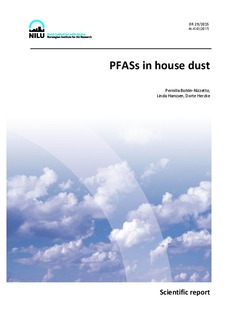PFASs in house dust
Research report
Permanent lenke
http://hdl.handle.net/11250/2383253Utgivelsesdato
2015Metadata
Vis full innførselSamlinger
Originalversjon
Bohlin-Nizzetto, P., Hanssen, L., Herzke, D. (2015) PFASs in house dust. Kjeller, NILU (Miljødirektoratet rapport, M-430/2015) (NILU OR, 29/2015).Sammendrag
NILU has, on behalf of the Norwegian Environment Agency, performed sampling and analysis of house dust from Norwegian households. The goal was to study concentration ranges, and variability between- and within-houses of anionic and volatile per- and polyfluorinated alkyl substances (PFASs), including the regulated PFOA, as well as for total extractable organic fluorine (TEOF). The sampling was done in six separate rooms in six different households. The analysis covered a suite of 20 targeted PFASs; ten of these were consistently detected in most samples while the other ten were below detection limit in the major part of the samples. A range of the targeted PFASs were detected in all rooms except in one room in one household in which all PFASs were below detection. The concentrations of individual PFASs as well as the sum of PFASs were lower than a previous study in Norway. The results show significant variability between houses for the anionic and volatile PFASs as well as for TEOF. For anionic PFASs, the results also indicate within-house variability with higher concentrations in dust from bedrooms (children and parents) and living rooms than in dust from bathroom, kitchen and entrances. For the volatile PFASs and TEOF, no significant difference between rooms were found. These results indicate that factors like building materials and consumer products (e.g., furniture, textiles etc.) affect the levels of PFASs in house dust but the reason for the findings are not further evaluated in this report. Anionic PFASs seem to contribute significantly to the TEOF (10-100%) in house dust.
Serie
NILU OR;29/2015Norwegian Environment Agency; M-430|2015
